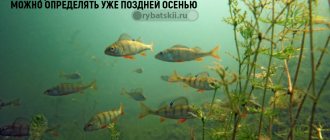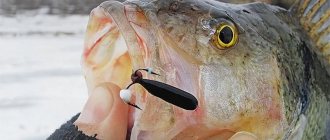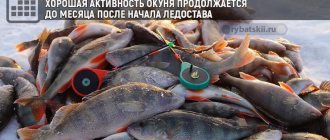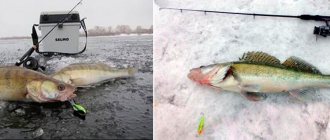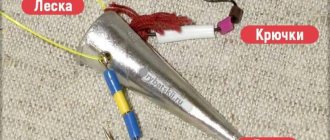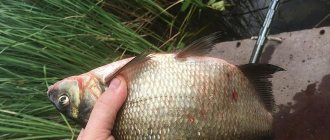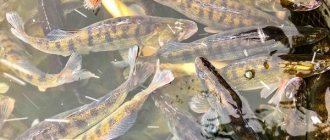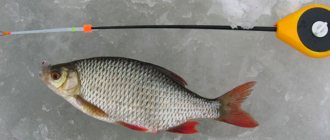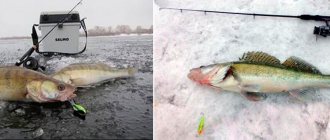Methods for catching minnows
During family vacations, on rivers where minnows are a common fish, catching them can be a fun activity for children and other novice anglers. For children's fishing, a simple jar filled with bread crumbs and tied with gauze with a hole can serve. No less fun can be catching these fish simply with a piece of gauze and lowered to the bottom. An important element of such fishing is releasing the fish into the wild. For more serious anglers, various bottom and float gear may be useful for fishing. Don’t forget that minnows can serve as excellent bait when catching predatory fish. In Europe, many tackles have been invented for fishing for “dead” fish or live bait using minnows.
Catching minnows with float tackle
Minnow is a bottom-dwelling fish; confident bites occur when the bait is located right next to the fish. When fishing with float gear, you must take into account the fact that the bait should drag along the bottom. Most often, in rivers, minnows are caught at shallow depths, so you can fish “wading”, stirring up the water with your feet, attracting a school of minnows. There is no need for complex and expensive gear. A light rod, a simple float, a piece of fishing line and a set of sinkers and hooks are quite enough. In case of frequent snags, it is possible to use a thinner leash. When fishing with a fishing rod, you should take into account the size of the fish and, accordingly, the size of the equipment, especially hooks and nozzles, which can affect the catchability of the equipment.
Minnow fish - appearance, habitat, behavioral characteristics, fishing for minnows
Fish, regardless of habitat, practically do not differ in weight and size.
They have a wide body, an elongated caudal peduncle, a small head with a short blunt nose, a small mouth, and rounded fins. The average size of an individual is 10-12 cm, large specimens (found in lakes) grow up to 15 cm in length. The weight of one fish is in the range of 15-100 grams. Males are smaller than females and have a more intense color (especially during the spawning period). The body of the minnow is covered with inconspicuous small scales. There are no scales on the belly. The palette of the main coating includes bright rainbow shades - golden, greenish-yellow, lilac, gray, red. The lateral line is black only reaching the middle of the body. The belly is white.
The usual habitat is fast-flowing rivers, streams, well-aerated reservoirs, a prerequisite for existence is clean, fresh, cool water. The fish prefer to stay in schools, choosing places near aquatic vegetation, flooded snags, rocky shores, and mill wheels. They feed on small worms, caviar, young fish, midges, mosquitoes, microscopic crustaceans, and sometimes algae.
In summer, minnow fish are found on rocky rifts and rapids; in winter, they go deeper or bury themselves in silt. Females begin to spawn at the age of two to three years. The spawning period occurs in May–June. Under natural conditions, fish live no more than 5-8 years.
Minnow
There are many types and methods of fishing known to avid fishermen, where it is impossible to do without proper skill and knowledge. For beginners, many of them are inaccessible, and this despite the abundance of useful tips and extensive information in specialized literature. Those whose first experience will be minnow fishing will be able to quickly become familiar with the mystery of the craft and boast of a good catch.
A small fish from the carp family has no commercial value and is most often used as live bait when catching larger predators (burbot, trout, pike, perch and others). It serves as their favorite treat and an important source of nutrition. The genus Phoxinus (minnows) includes more than 10 species. The distribution area covers the northern regions of Asia and almost all of Europe.
Minnows are small freshwater fish belonging to the carp family. As a rule, these fish are found in rivers with fast currents - in European and Asian countries and in North America. Also, some of the numerous species of minnow have adapted to life in lakes and tributaries of swamps.
Read about what kind of fish a minnow is, what it looks like, what it eats and what are the characteristics of its behavior, as well as how fishing for a minnow works.
There are 19 species of minnows in total, the most common of which is the common minnow, or Phoxinusphoxinus. It is also otherwise called “demoiselle minnow” or “blue minnow”.
Habitat
Minnows are found in freshwater bodies of water. Thus, they live in rivers and streams of European countries, for example, the Neman and Dnieper, in Russia - in the Arkhangelsk region, Vologda region and Karelia, as well as almost everywhere in Siberia. In the Middle Urals, minnows can be found in rivers near the Ural ridge. This fish can also be found in lakes where there is clear and clean cool water.
In addition, quite aggressive behavior of minnows is often observed, which is especially evident in the evening. This fish can attack other fish, both smaller and larger than it, kill and eat them or gnaw off their fins.
Diet
Minnows are eaten:
- small invertebrates,
- flying insects, such as mosquitoes,
- seaweed,
- pollen from plants,
- caviar and fish larvae,
- worms,
- plankton,
- dry fish food.
But the minnows themselves often become prey for large predatory fish.
When to catch?
Minnow fishing can be done year-round. However, in the cold season the bite is much worse. So, a minnow can be caught on a jig at the beginning of winter, and when frost sets in, it stops biting. At this time, he usually buries himself in the mud.
How to catch?
Usually these fish gather in schools and stay on the surface of reservoirs. They are unpretentious and can take any bait.
Small representatives are quite easy to catch, but larger individuals stay under snags and in grass thickets and can get scared at the sight of a fisherman. Therefore, if your goal is a large representative of this type of carp, then the casts should be done carefully and as quietly as possible, and the fisherman himself should be in cover.
Gear used
Minnows are usually caught on:
- a float rod with a thin fishing line, as well as a small hook,
- jig,
- with the help of nonsense,
- networks.
There is also a quick way to minnow using an old bucket. It is usually used by villagers who catch minnows for food, or by fishermen looking for bait to fish for predator fish.
Holes are made in it so that the water quickly pours out when taken out of the reservoir. A crust of bread is usually placed in a bucket, after which it is placed in a reservoir at a depth of approximately seventy to eighty centimeters.
It also happens: Fishing with a jig - choice of gear, types of jig heads, fishing methods, videos, professional advice
The catch is usually checked after an hour and a half to two hours. Usually, by this time, a great variety of small fish are collected in the bucket, including minnows, loaches and minnows, which will serve as excellent bait for large predators.
Constant search and movement is the key to success in fishing, especially when we catch minnows. If you want to achieve maximum success, you will have to stomp your shoes quite a bit! In this case, the lazy person will be left without fish.
Fishing in this place is good only if you are absolutely sure that a minnow lives in this place. A minnow is a schooling fish, so if you attack a school and, frankly speaking, a school for a minnow is 50-60 individuals, you will not be left without a catch.
If the minnow is not in the open area of the reservoir, welcome to overgrown shallow water, where the fish hides in a cluster of algae.
What a minnow he is!
about minnow
Be the first to voteLoading…
The carp family has several dozen varieties, and not all of them are large in size and have tasty, valuable meat. The baby minnow fish is also included in this huge family. Catching minnows is a simple and interesting process that will bring considerable benefits, because you can easily stock up on valuable bait and go hunting for large predators.
Minnow is a small fish that rarely exceeds ten centimeters in size. Babies 17-20 cm long can be considered trophy specimens; they are rare. The weight of the fish will not impress even the most undemanding fisherman - only 100 grams. Do babies have teeth? Like large predators, the fish have sharp, albeit small, teeth.
What does a minnow look like? The baby's body can be compared to a small spindle, slightly flattened on the sides. The color is variegated, the back is dark, and the belly is almost white, without scales. It is easy to distinguish individuals of the opposite sex - the fins of males resemble a chic fan, but those of females are narrow and rather short.
Interesting! Just before spawning, the minnow fish amazingly transforms, acquiring a gorgeous color.
The males differ here - the back darkens, all the fins turn red, and the belly becomes a rich crimson hue. The head is decorated with a scattering of small dots resembling pearls.
Minnows are found in almost every fresh body of water in Europe; the rivers and streams of Siberia are especially attractive to fish. Lakes with clear, clean water attract huge schools of fish, so hundreds of fishermen go here for live bait.
The minnow does not overeat with food, and in the evening, when the little ones are aggressive in their mood, flocks of little ones can even attack large predators. As the saying goes, “even if they don’t eat you, at least they’ll bite you” - small fish may well gnaw off the fins. If the school of minnows is large, then collectively they can eat their prey, many times larger than the largest minnow.
The daily diet is quite meager; the fish eat:
- fish fry;
- small invertebrates;
- different types of algae;
- plankton;
- caviar.
If you stock up on fish as live bait, you can keep them in a small container for quite a long time (most often they use a small jar for this). What do kids eat at home? You can feed them flies or mosquitoes; the little ones will happily eat the delicious treat.
Minnows cannot be called migratory fish - they lead a sedentary lifestyle in summer and winter, preferring throughout their lives not to move away from their places of birth.
They prefer rocky bottoms with lots of algae.
When all the food within reach has disappeared, schools of minnows can move several kilometers and continue life in a new place, but until hunger forces them to move further.
With a length of 4-7 cm, the fish is already completely ready for reproduction. Clean reservoirs with fast currents are excellent for this, which the minnow tries to find close to its habitat.
The spawning of the baby minnow has no special features and differs little from the reproduction of other inhabitants of freshwater bodies. The caviar is small, only one millimeter. Thanks to the adhesive substance, the eggs are securely attached to stones and pebbles.
The female is capable of laying only 200-400 eggs.
Interesting! Within a week, babies appear and are distinguished by their fearfulness - they immediately hide between stones and in algae. Thanks to this, most fish survive; predators cannot detect small fry in secluded corners. The peculiarity of minnow babies is that they are afraid of light and begin to rise to the surface almost before reaching puberty.
It also happens: Chet river fishing
You can catch live bait throughout the year, because even in cold seasons the minnow does not lose activity, continuing to actively feed. In winter, experienced fishermen use jigs, but in summer the process can be turned into an interesting action using different types of gear.
Photo 2. The simplest jig.
Fishing places and habitat
In Europe it is found everywhere, with the exception of the extreme southern and northern regions. In Russia it is known throughout almost the entire territory of the country from the European part to the Amur and Anadyr. Minnow is considered an “indicator” of the cleanliness of a reservoir. It can be found even in the smallest bodies of water. Accumulations of fish, especially in hot weather, near groundwater outlets. As already noted, the river minnow is sensitive to the oxygen saturation of the water. In lakes, the minnow adheres to the shallow coastal zone in search of zooplankton and plant food washed from the shore. In addition, the minnow can actively feed on small insects that fall to the surface of the water from ground vegetation or during flight.
